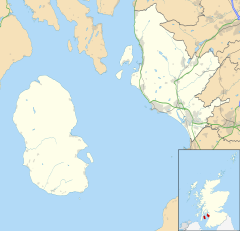Beith
Beith
|
|
|---|---|
| Beith shown within North Ayrshire | |
| Population |
6,346 (2001 census) |
| OS grid reference | NS349542 |
| • Edinburgh | 67 miles (108 km) |
| • London | 424 miles (682 km) |
| Council area | |
| Lieutenancy area | |
| Country | Scotland |
| Sovereign state | United Kingdom |
| Post town | BEITH |
| Postcode district | KA15 |
| Dialling code | 01505 |
| Police | Scottish |
| Fire | Scottish |
| Ambulance | Scottish |
| EU Parliament | Scotland |
| UK Parliament | |
| Scottish Parliament | |
6,346 (2001 census)
Beith is a small town situated in the Garnock Valley, North Ayrshire, Scotland approximately 20 miles (30 kilometres) south-west of Glasgow. The town is situated on the crest of a hill and was known originally as the "Hill o' Beith" (hill of the birches) after its Court Hill.
Beith's name is thought to emanate from Ogham, which is sometimes referred to as the "Celtic Tree Alphabet", ascribing names of trees to individual letters. Beithe in Old Irish means Birch-tree (cognate to Latin betula). There is reason to believe that the whole of the district was covered with woods. The town of Beith itself was once known as 'Hill of Beith' as this was the name of the feudal barony and was itself derived from the Court Hill near Hill of Beith Castle.
Alternatively, Beith may be derived from Cumbric *baɣeδ, 'boar' (Welsh baedd). The local pronunciation of the name would favour this theory.
The Wood of Beit, now the 'Moor of Beith', has been identified as an Arthurian site where according to Taliessin in a poem under the name of 'Canowan' it was the site of a battle in the wood of Beit at the close of the day.
Beith is said to have been the occasional residence of Saint Inan, a confessor of some celebrity, whose principal place of abode was Irvine. He flourished about 839. Although he is said to have been a hermit, according to tradition Saint Inan often visited Beith, frequenting Cuff Hill with its Rocking Stone and various other prehistoric monuments. A cleft in the west-front of Lochlands Hill is still known as "St. Inan's Chair" and said to have been used by the saint as a pulpit. An unsuccessful search for the saint's writings which were said to be preserved in the library of Bonci, Archbishop of Pisa, was made by Colonel Mure of Caldwell in the 19th-century.
...
Wikipedia

